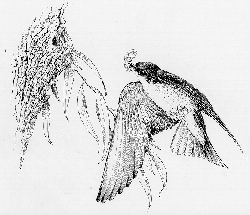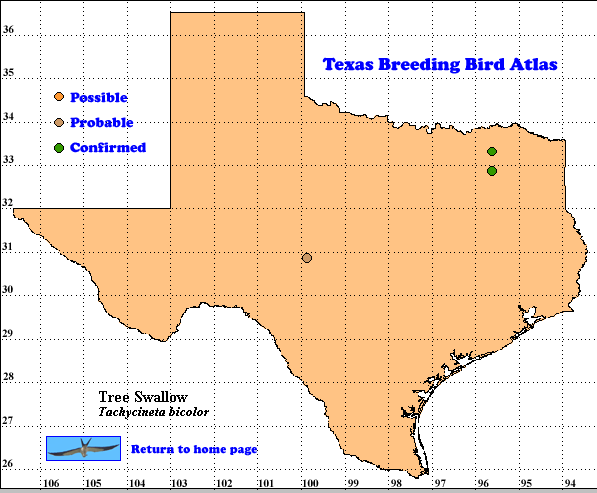Tachycineta bicolor
The Tree Swallow breeds across much of North America, north of Mexico; it is absent from the northern-most part the continent, but breeds southward to southern California, central Nevada, central Arizona, south-central New Mexico, northeastern Louisiana, west-central Mississippi, Tennessee and North Carolina (A.O.U. 1983). The species formerly bred in south-central Texas (Oberholser 1974, A.O.U. 1983). The Tree Swallow is generally sporadic or irregular as a breeder east of the Rocky Mountain states and south of the upper Mississippi and Ohio valleys and along the Atlantic coast (A.O.U. 1983).
DISTRIBUTION: In Texas, the TBBA data include three records, all reported in 1991. The two reports of active nests come from the northeast corner of the state, in Rains and Wood counties. The third record, from Menard County in west-central Texas, also may represent an active nest, as the details submitted by the observers and the date of the observation strongly suggest either nest site selection or an active nest (S. Wiedlefeld, pers. comm.).
SEASONAL OCCURRENCE: The Tree Swallow, like most species in the family, is easily confirmed, as the adults regularly circle around the nest site during the nesting period. The two confirmed records reported to the TBBAP included adults on the nest on 3 June and young in the nest on 8 June.
Three records reported in Oberholser (1974) included a nest with 6 eggs and several nests with young on June 1, a nest with young on June 11, and a nest with two nearly-grown young on June 6. Austin and Low (in Tyler 1942) reported an incubation period of 13 -16 days and a nestling period of 16 – 24 days. Thus, eggs of the nest with nearly-grown young on June 6 must have been laid no later than May 10 and perhaps as early as April 28. If the eggs in the nest reported for June 1 were viable and hatched the day after discovery, the nest would have remained active at least until June 17 and perhaps as late as June 25.
The TBBA report for young in the nest (32095, quad H5) likely represents nearly-grown young seen in the cavity entrance; hence, egg-laying probably took place around 2 May and possibly as early as 25 April.
BREEDING HABITAT: Tree Swallows often use man-made structures for nesting sites, usually “bird houses,” although they have used other man-made sites (Tyler 1942). Most nest sites occur over or near bodies of water, but these birds will also use houses placed in open areas for bluebirds. Whittle (in Tyler 1942) states that the primary factor in selecting a site “..is the adequacy of a nearby feeding area…to furnish the necessary quantity of food for the young at the requisite period.”
The nest cavity may be a nest box on a fence post or in an exposed position over water or in open meadows. Although the species often breeds as individual pairs, abundant cavities, man-made or natural, often lead to groups of Tree Swallows nesting close together. As with the Menard county record, Tree Swallows also use woodpecker cavities or cavities formed by rotted limbs.
STATUS: The status of the Tree Swallow in Texas remains an enigma. The two reports of active nests come from a region for which we have no previous nesting records. Previous nesting records all came from Bexar county (Oberholser 1974). The single record from Menard county occurred northwest of the old Bexar county locations and at a great distance from those in northeast Texas. Only continued observation of these two areas will help us understand whether we have the beginnings of a resident breeding population or if this represents another “sporadic irruption” at the southern limits of the range.
Text by Keith A. Arnold (ca. 1993)
Literature cited
American Ornithologists’ Union. 1983. Check-list of North American birds, 6th ed. American Ornithologists’ Union, Washington, DC.
Oberholser, H. C. 1974. The Bird Life of Texas. vol 2. University of Texas Press, Austin.
Tyler, W. M. 1942. Tree Swallows, pp. 384-400 in Life histories of North American flycatchers, larks, swallows, and their allies (A. C. Bent, ed.). U. S. Natl. Mus. Bull. 179..

